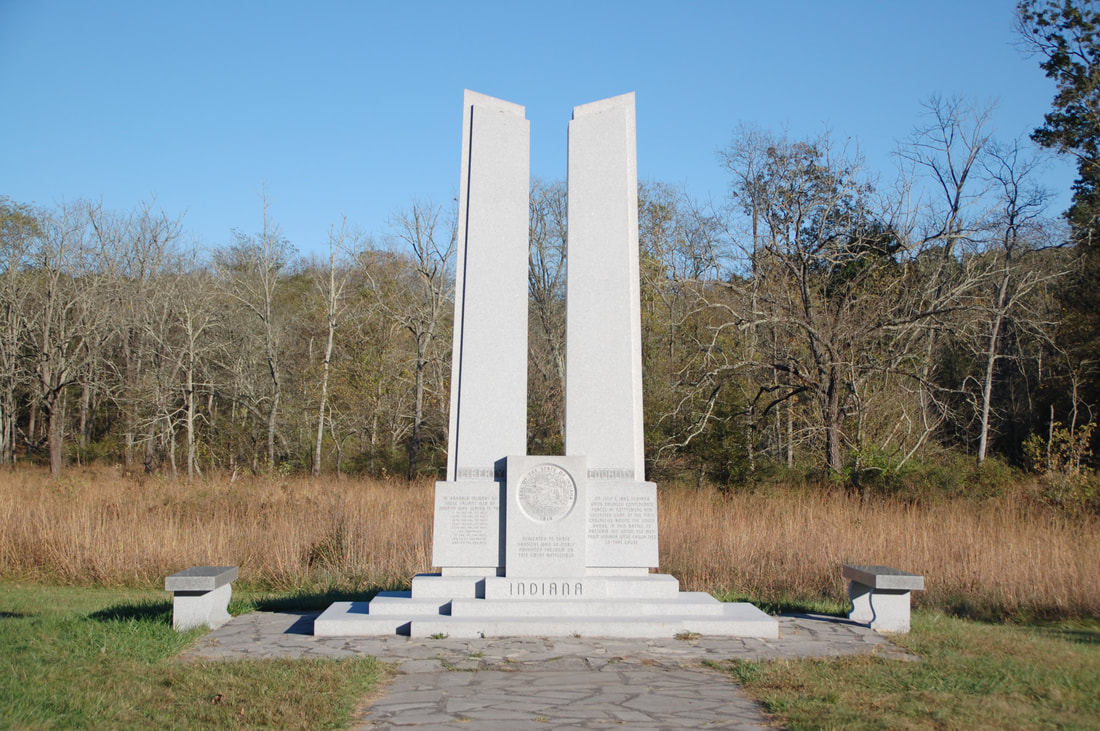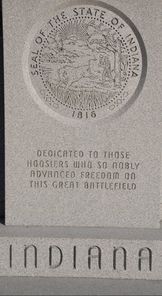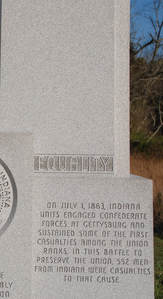|
With all of the attention on Confederate monuments recently, I am happy that at least some of the discussion is around the idea that monuments are frequently inaccurate representations of the events they commemorate but faithful representations of the attitudes of those who built the monuments. What and how we, as a society, choose to commemorate says less about the nobility and honor of the acts and people we are remembering and more about what we find noble and honorable and memorable in those acts and people. Values change as society changes, and our commemorative landscape can act as a time capsule showing us exactly what society deemed important at the moment that the memorial was built. When I went to Gettysburg so I could photograph some of the beautiful commemorative artwork on park grounds, I never anticipated such a clear cut example of this in a small, unobtrusive state monument tucked near where the tour road begins its ascent of Culp’s Hill. Some people who have been following the Confederate monument debate may be surprised, even, that this perfect example of what so many historians have been saying about commemoration and memory is actually a Union monument. I am a Hoosier born and raised, so this is not the first time I have seen the Indiana State Monument. It is the first time, however, I took a close look at the monument. Nearly 13 feet high, the monument features two granite pillars, labeled Liberty and Equality. The central panel features a carved relief of the State Seal of Indiana over the words: Dedicated to those Hoosiers who so nobly advanced freedom on this great battlefield. On the left panel, underneath the Liberty pillar, are the words: In honored memory of those valiant men of Indiana who served in the: 7th Ind. Vol. Inf. Regt.; 14th Ind. Vol. Inf. Regt.; 19th Ind. Vol. Inf. Regt.; 20th Ind. Vol. Inf. Regt.; 27th Ind. Vol. Inf. Regt.; I & K Companies 1st Ind. Vol. Cav. Regt.; ABCDEF Companies 3rd Ind. Vol. Cav. Regt. On the right panel, under the Equality pillar, are the words: On July 1, 1863, Indiana units engaged Confederate forces at Gettysburg and sustained some of the first casualties among the Union ranks. In this battle to preserve the Union, 552 men from Indiana were casualties to that cause. The monument itself sits upon a patio of Indiana limestone and is flanked by two benches where visitors may rest and reflect. There is something on this monument that very specifically dates its creation. Can you find it? To help you, let’s take a closer look at the words used on this monument. The description of the action for the Indiana regiments is an accurate depiction of the battle. The 19th Indiana was one of the five “western” regiments that made up the Iron Brigade, the first Union infantry troops on the battlefield on July 1st. The brigade’s losses were heavy and Gettysburg was essentially the last time that the Iron Brigade was the fearsome, aggressive fighting force that had won its nickname at the Battle of South Mountain in September 1862. The short dedication focuses on advancing freedom with success on the battlefield. After the Emancipation Proclamation went into effect on January 1, 1863, Washington, D.C.’s war goals were expanded from simply union to union and emancipation. Lincoln echoed the idea of freedom through victory in battle in November of 1863 in his immortal Gettysburg Address. Liberty is defined as the state of being free within society from oppressive restrictions imposed by authority on one’s way of life, behavior or political view. Liberty is one of the key concepts of the Declaration of Independence, the underlying framework for Lincoln’s speech. Equality is mentioned in the Declaration of Independence, too, however, it is a concept relatively anachronistic in the Civil War. Certainly, the words “dedicated to the proposition that all men are created equal” are included by Lincoln in his monumental speech. However, the historical record shows that even in the north, where slavery was outlawed by state constitutions, emancipation did not equal racial equality. This is certainly true in Indiana, where the second version of Indiana’s Constitution, passed in 1851, included Article XIII: Negroes and Mulattoes with the following provisions:
Though Article XIII was removed in 1881, Hoosier soldiers fighting at Gettysburg came from a state that, despite outlawing slavery, was not interested in establishing equality for black freedmen and freedwomen.
The inclusion of the term “equality” however, does give us an idea of when this monument was created. Google N Gram can show us when terms associated with “equality” began to appear in print. The non-qualified word “equality” has been more popular than either “racial equality” or “negro equality”, but the first two terms had notable increases in usage in the 1960s which corresponded to the Civil Rights movement. The term “equality” peaked in usage for the 217 year span beginning in 1800 and ending in 2017 in 1974. A monument designed and built in the immediate aftermath of that societal shift focusing on the attainment of equal rights for blacks, the removal of segregation, and the legal recognition and federal protection of the citizenship rights in the United States Constitution, would certainly look at the Civil War as the first step along the long, circuitous and halting journey toward the equality gained from the Civil Rights Movement. The Civil Rights Movement ended in 1968. The monument was built in 1970.
3 Comments
3/17/2023 01:43:44 pm
Great Article.Thnks for sharing .I have been searching for such an informative post since many days and it seems my search jst ended here.Good work.Keep posting.
Reply
3/18/2023 12:44:18 pm
That even in the north, where slavery was outlawed by state constitutions, emancipation did not equal racial equality. This is certainly true in Indiana, Thank you, amazing post!
Reply
8/12/2023 12:59:54 pm
The historical record shows that even in the north, where slavery was outlawed by state constitutions, emancipation did not equal racial equality. This is certainly true in Indiana, I’m so thankful for your helpful post!
Reply
Leave a Reply. |
AuthorToni is a wife, mom and history buff who loves bringing the Civil War to life for family members of all ages. Archives
July 2018
Categories
All
|



 RSS Feed
RSS Feed